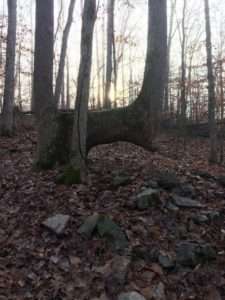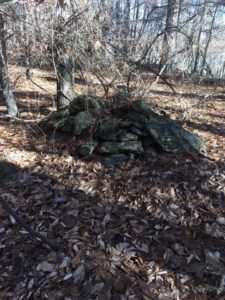
Very few physical traces of Sugar Hill and Gwinnett County’s early Native American history exist today. The history is both significant and tragic, and it played a role in shaping our community. Place names give us some evidence of the history. Words like Suwanee, Chattahoochee, and Apalachee have links to a time in history long before the first European settlers set foot in Gwinnett County. Occasionally a lucky individual might find an arrowhead or a piece of pottery, which gives us something tangible to hold in our hands and helps us imagine a time when the area now called Sugar Hill was considered a frontier community. Suwanee derived its name from a large Native American village that was located along the banks of Suwanee Creek, which flows into the Chattahoochee River. Frequent arrowhead and pottery finds at the Sugar Hill Golf Course and the new E. E. Robinson Park might also provide evidence of an additional Native American village or at least extensive hunting activity in these areas. Mysterious rock mounds and bent trees can also be found in wooded areas all around Sugar Hill.

Archaeological evidence at sites near the Chattahoochee River, including the area where the Georgia Highway 20 Bridge crosses into Forsyth County suggests that Native Americans inhabited the area for thousands of years. The Creek and Cherokee Indians occupied Gwinnett County and the area that is now Sugar Hill for perhaps a couple hundred years before westward expansion brought European settlers into the area. When the Cherokee Indians ceded land in 1789 and 1790 to the United States, it first opened up this part of Georgia to settlements like the early communities of Hog Mountain and Suwanee. Settlement patterns were sparse until the War of 1812 changed the relationship between the early settlers and the remaining Creek Indians that were left east of the Chattahoochee River. Fort Daniel, near Hog Mountain, was built for added protection for the frontier community since the Creek Indians were allied with the British. Fort Peachtree, near what is now Atlanta, was also built to protect settlers. The two forts, and the road connecting both to each other, opened up this area to an influx of additional settlers and commerce. This dynamic further pushed Native American presence further west and by 1826, nearly eight years after Gwinnett County’s founding in 1818, even the Creek Indians had been completely pushed well beyond the western side of the Chattahoochee River.
Sugar Hill’s own history as a community is deeply connected to this legacy of give and take between European settlement and the Native Americans that once occupied this area along the Chattahoochee River. According to a May 1, 1987 article in The Forum about Orrsville, the river settlement that would shape and evolve into Sugar Hill has links to the Cherokee Indians. William Orr’s postal community, which was also serviced by a general store and ferry crossing, included both sides of the Chattahoochee River near the mouth of Dave’s (Daves) Creek. The creek was “named for David Cordery, half-blood Cherokee son of Thomas Cordery and Susannah Sonicooie.” The property that would become the west bank ferry landing, as of a survey in 1832, still belonged to Charlotte Vickery, a woman of partial Cherokee descent. Charlotte would later be disposed of her title to the property in 1835 following the Cherokee Gold Lottery.
One of the Sugar Hill area’s earliest settlers, Thomas Kile, Sr., also provides a tragic link to the history of Native Americans in this part of Gwinnett County. In 1838, as part of serving in the Gwinnett County Militia, Hamilton’s Company, Thomas would be called into service to help with the Cherokee Indian Migration or the Trail of Tears. Forcible removals began in May 1838 when General Winfield Scott, setting up headquarters at New Echota in Georgia, received a final order from President Martin Van Buren to relocate the remaining Cherokee Indians in the state. Thomas would finish his service and stay in what is now Sugar Hill as a farmer until his death in 1862 at the age of 83. He is buried in the Kile-Benson Family Cemetery on Sycamore Road near Richland Creek.
Despite the lack of much physical evidence of Native American presence in Sugar Hill, it is not hard to understand why this would have been an attractive area for settlement. The same beautiful landscape with hills, streams, and wildlife would have made this area a good place to live. Walking in the woods along the Chattahoochee River, I sometimes feel their presence and the impact the Creek and Cherokee Indians and their forefathers had on our community.
— By Brandon Hembree



